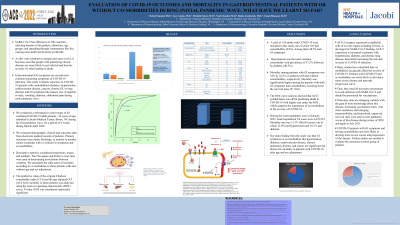Back


Poster Session B - Monday Morning
Category: Stomach
B0691 - Evaluation of COVID-19 Outcomes and Mortality in Gastrointestinal Patients With or Without Co-Morbidities During Initial Pandemic Wave: What Have We Learned so Far?
Monday, October 24, 2022
10:00 AM – 12:00 PM ET
Location: Crown Ballroom

Has Audio

Vishal Chandel, MD
Suburban Community Hospital
Norristown, PA
Presenting Author(s)
Vishal Chandel, MD1, Ayce Atalay, MD2, Neel Chandel, MD3, Michelle Stern, MD2, Robin Zachariah, MD4, Emad Mansoor, MD5
1Suburban Community Hospital, Norristown, PA; 2Jacobi Medical Center, Bronx, NY; 3Roxborough Memorial Hospital, Philadelphia, PA; 4Duke Health, Durham, NC; 5University Hospital Medical Center, Cleveland, OH
Introduction: Gastrointestinal (GI) symptoms are second most common presenting symptoms of COVID-19 infection. This study evaluates outcomes in COVID-19 patients with comorbidities (diabetes, hypertension, cardiovascular disease, cancers, chronic GI or lung disease) and GI symptoms like nausea, loss of appetite or taste, vomiting, diarrhea, abdominal pain during early pandemic wave.
Methods: We conducted a retrospective study of all confirmed COVID-19 adult patients >18 years of age, admitted in our center for a period of 6 weeks during March-April 2020. We extracted demographic, clinical and outcomes data from patient’s electronic medical records. Primary outcomes were death, discharge, or transfer in patients with or without GI symptoms and comorbidities. Charlson comorbidity index (CCI) was used for analysis of mortality using the receiver operating characteristic (ROC) curve.
Results: From 124 patients included in this study, 103 had comorbidities (83%). Among them 48.5% had GI symptoms. Mortality among patients with GI symptoms was 34% & 14.2%, in patients with and without comorbidities, respectively. Mortality was significantly higher among the patients with both GI symptoms and comorbidities, lowering down the survival rates (P< 0.01). The ROC curve showed that CCI yielded better cut-off for predicting death in COVID-19 with higher area under the ROC, which supports the importance of comorbidities in the severity of COVID-19.
Discussion: Our main finding was that GI symptoms in comorbid patients are significant risk factors for mortality after age and sex adjustment. ACE-2 receptor, expressed in epithelial cells of GI tract, is the target for SARS-CoV-2 binding. Its expression is increased in comorbid conditions; henceforth increasing the risk and severity of COVID-19 infection. COVID-19 patients with GI symptoms and having comorbidities are more likely to develop more severe course and progression of the disease. Further studies are needed to evaluate the outcomes in these group of patients.

Disclosures:
Vishal Chandel, MD1, Ayce Atalay, MD2, Neel Chandel, MD3, Michelle Stern, MD2, Robin Zachariah, MD4, Emad Mansoor, MD5. B0691 - Evaluation of COVID-19 Outcomes and Mortality in Gastrointestinal Patients With or Without Co-Morbidities During Initial Pandemic Wave: What Have We Learned so Far?, ACG 2022 Annual Scientific Meeting Abstracts. Charlotte, NC: American College of Gastroenterology.
1Suburban Community Hospital, Norristown, PA; 2Jacobi Medical Center, Bronx, NY; 3Roxborough Memorial Hospital, Philadelphia, PA; 4Duke Health, Durham, NC; 5University Hospital Medical Center, Cleveland, OH
Introduction: Gastrointestinal (GI) symptoms are second most common presenting symptoms of COVID-19 infection. This study evaluates outcomes in COVID-19 patients with comorbidities (diabetes, hypertension, cardiovascular disease, cancers, chronic GI or lung disease) and GI symptoms like nausea, loss of appetite or taste, vomiting, diarrhea, abdominal pain during early pandemic wave.
Methods: We conducted a retrospective study of all confirmed COVID-19 adult patients >18 years of age, admitted in our center for a period of 6 weeks during March-April 2020. We extracted demographic, clinical and outcomes data from patient’s electronic medical records. Primary outcomes were death, discharge, or transfer in patients with or without GI symptoms and comorbidities. Charlson comorbidity index (CCI) was used for analysis of mortality using the receiver operating characteristic (ROC) curve.
Results: From 124 patients included in this study, 103 had comorbidities (83%). Among them 48.5% had GI symptoms. Mortality among patients with GI symptoms was 34% & 14.2%, in patients with and without comorbidities, respectively. Mortality was significantly higher among the patients with both GI symptoms and comorbidities, lowering down the survival rates (P< 0.01). The ROC curve showed that CCI yielded better cut-off for predicting death in COVID-19 with higher area under the ROC, which supports the importance of comorbidities in the severity of COVID-19.
Discussion: Our main finding was that GI symptoms in comorbid patients are significant risk factors for mortality after age and sex adjustment. ACE-2 receptor, expressed in epithelial cells of GI tract, is the target for SARS-CoV-2 binding. Its expression is increased in comorbid conditions; henceforth increasing the risk and severity of COVID-19 infection. COVID-19 patients with GI symptoms and having comorbidities are more likely to develop more severe course and progression of the disease. Further studies are needed to evaluate the outcomes in these group of patients.

Figure: The receiver operating curve (ROC) showing that CCI (Charlson Comorbidity Index) yielded better cut-off for predicting death in COVID-19 with higher area under the ROC
Disclosures:
Vishal Chandel indicated no relevant financial relationships.
Ayce Atalay indicated no relevant financial relationships.
Neel Chandel indicated no relevant financial relationships.
Michelle Stern indicated no relevant financial relationships.
Robin Zachariah indicated no relevant financial relationships.
Emad Mansoor indicated no relevant financial relationships.
Vishal Chandel, MD1, Ayce Atalay, MD2, Neel Chandel, MD3, Michelle Stern, MD2, Robin Zachariah, MD4, Emad Mansoor, MD5. B0691 - Evaluation of COVID-19 Outcomes and Mortality in Gastrointestinal Patients With or Without Co-Morbidities During Initial Pandemic Wave: What Have We Learned so Far?, ACG 2022 Annual Scientific Meeting Abstracts. Charlotte, NC: American College of Gastroenterology.
